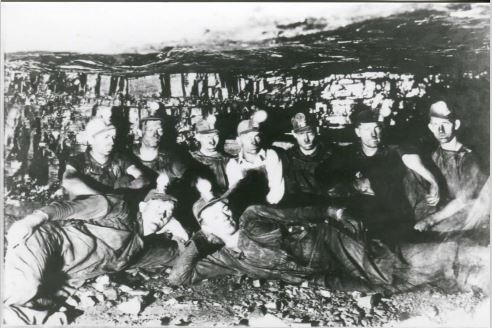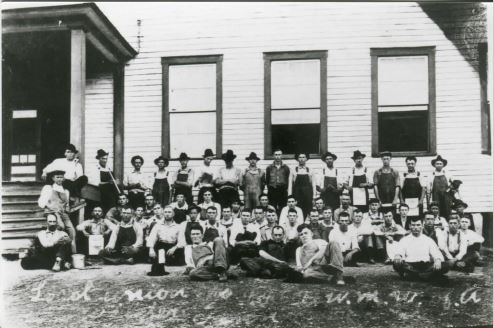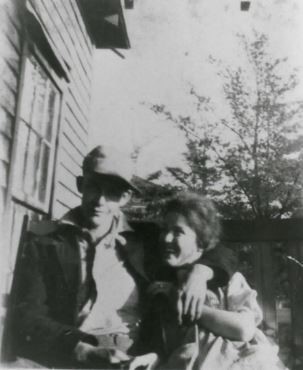by August Pitcher, Archive Intern

From 1909 to 1939, Fentress County was home to a sprawling coal-mining community. Wilder-Davidson, as the region was known, encompassed the towns of Wilder, Davidson, Crawford, Twinton, and Highland. The Fentress County Coal and Coke Company’s owner, John T. Wilder, established the town in 1902, and its population increased dramatically as the railroad system made its way across the United States. By 1909, over two thousand people lived in Wilder alone. Now, the town is nearly deserted. What happened to Wilder-Davidson?
Wilder-Davidson operated as a company town during the “Coal Boom” of the early twentieth century. Though Fentress County Coal and Coke Co. owned nearly everything in the town, workers were compensated well in the early years. Miners could afford luxuries like radios and cars, and their families enjoyed a strong school system, religious community, and social activities. Former miner and Wilder resident Tom Lowery described the town as safe and close-knit, saying “women were respected a great deal” and “people slept with the doors unlocked.”

Yet, the friendly Appalachian town was not perfect. Miners faced dangerous working conditions daily as they labored in mines filled with coal dust, methane gas, and explosives. Several lost their lives or limbs in accidents, and many suffered long-term health effects (like ‘black lung disease’) long after their time in the mines. As the nation’s economy suffered during the Great Depression, workers saw dramatic pay cuts and began to organize in protest. The union’s first strike occurred in 1924 and lasted a few months before the company agreed to worker demands, though pay was still not back to pre-Depression rates. Company/worker relations stabilized until February 13th, 1928, when a powder keg was struck and killed four miners. After the tragedy, workers began to discuss organizing again, as they believed they were not fairly compensated for putting their lives on the line daily.
In 1931, miner Byron “Barney” Graham was elected union president just before the company would issue three major pay cuts. The union was outraged and went on strike on July 9, 1932. Out-of-town, non-union miners (Called “scabs” by union workers) worked until the mines were officially reopened on October 19. Strikebreakers and National Guard units accompanied miners, but workers on strike sought to rid the mines of these groups. They blew up stretches of railroad, destroyed a tipple (structure to load coal onto transportation) worth $20,000, and shot at strikebreakers and mine guards. One Davidson mine superintendent was killed, and the company realized it had little control over its employees.

On April 30, 1933, union president Barney Graham was killed on the steps of the company store by Jack “Shorty” Green, a mine guard. Though a few witnesses were present, the exact events and motives of the murder have been muddled after decades of speculation. Despite the disagreement in details by many former residents, most agree that Graham’s death signified the end of the strike. For a few months after, many miners hoped that conditions would improve but left Wilder-Davidson when they did not. Many “blacklisted” miners were able to find government jobs after the National Labor Relations Act of 1935 was passed, granting union members protection from anti-union policies from employers. The company never fully recovered from the destruction caused by the strike and worker shortage, causing the town to dissolve slowly. Some mining activity continued until the 1950s when Fentress Coal and Coke Company abandoned Wilder-Davidson and moved its headquarters to Monterey, Tennessee. By the 1970s, much of what had once been an active and vibrant community had been destroyed.
“The stories of former residents of Wilder-Davidson are an incredibly powerful reminder that history is built on lived experiences–not just words on a page.”
On March 1st, 1984, Dr. Homer Kemp and a research team from the Upper Cumberland Humanities and Social Sciences Institute at Tennessee Technological University submitted a proposal to the Tennessee Committee for the Humanities. The proposed project would research the history of Wilder primarily through the collection of former residents’ oral histories. The Wilder-Davidson project sought to preserve the town’s legacy and those who lived in it using primary sources and scholarly writings on coal mining. The Committee approved the project, which ran from July 20, 1984, to February 28, 1986. The project made the Wilder-Davidson Project records possible through the work of a large team of interviewers, historical experts, camera operators, and the Cookeville PBS station (WCTE). The result of the project was The Wilder-Davidson Story: The End of An Era, a four-part documentary broadcast by WCTE on June 17, 1987.

My role in this project was to organize and catalog all materials, research the region’s history and the WCTE project, and prepare the collection for public access. Though all the records contain historical value, one story stuck out. Madge Alexander was born and raised in Wilder and had an active social life as a young woman. She went on to marry her neighborhood sweetheart, Charlie, and they enjoyed a happy life together. However, Charlie was working in the mines on the night of February 13, 1928, and was seriously injured in the blast. The injured were taken by train to Nashville, but it was too late. Charlie died a few days later. His last words to Madge were, “Oh woman, don’t you worry about me, I’ll be alright.” As Madge said in her 1985 interview, “It was horrible. I thought it would kill me; I really did. I was just 23 years old, and he was just 31. But you have to make a life and go on… I thought I would die, really, I did. You get over that terrible horror after a while, but you never really get over it.”
The stories of former residents of Wilder-Davidson are an incredibly powerful reminder that history is built on lived experiences–not just words on a page. Though the people who shared their experiences for the documentary have since passed away, their interviews have been digitized. They are available in Tennessee Tech’s digital collections by following this link. All four parts of the documentary, The Wilder Davidson Story: The End of an Era, can be found on the American Archive of Public Broadcasting website using this link. The finding aid for this collection is available at the following link.
